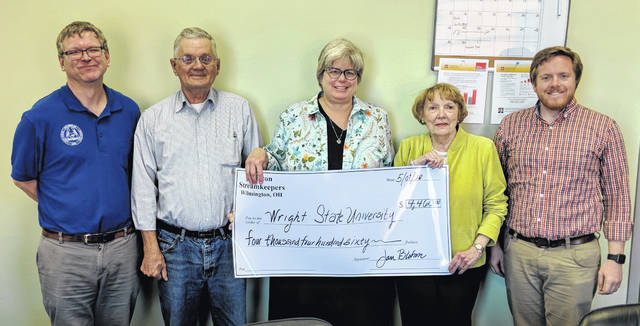
WILMINGTON — A harmful algal bloom at Caesar Creek Lake forced the City of Wilmington to switch water sources for almost a month in the spring of 2017.
The Clinton Streamkeepers have awarded a $4,460 grant from its Sture Fredrik Anliot Fund to launch a study of the causes of harmful algal blooms in the lake, which is the primary drinking water source for Wilmington.
Harmful algal blooms are a result of elevated nutrient levels in a body of water. The blooms often produce toxins that must be removed from the water during the treatment process, which can be difficult.
While the Wilmington water plant was successful in removing the toxins during the 2017 bloom, higher toxin levels in the lake water could be problematic in the future.
The study will be led by Audrey McGowin, Associate Professor of Chemistry at Wright State University. In coordination with the Wilmington Water Department and Clinton County Regional Planning Commission, water and sediment samples will be tested over the next 15 months.
The data will be used to identify the potential sources of the nutrients — phosphorus and nitrogen — that lead to the harmful blooms.
Once identified, the city will encourage land owners in the watershed to employ best management practices to prevent the nutrients from entering the lake.
“Mayor John Stanforth and city council have already committed resources to a source water protection program. This grant will allow the program to hit the ground running,” said Wilmington Water Superintendent Rick Schaffer.
“The Anliot grant, Audrey McGowin’s expertise and Wright State’s resources will give our source water protection program the opportunity to achieve meaningful results years sooner than otherwise would be possible.”
The city is also in the process of upgrading facilities at the water plant so that it will be better equipped to remove algal toxins from the water. The infrastructure at the city’s back-up reservoirs at Burtonville are also being improved so that there will always be a source of safe drinking water available to Wilmington’s citizens.
“After last year’s bloom, Ohio EPA required the City to develop multiple barriers to prevent algal toxins from contaminating the drinking water,” Schaffer said. “EPA has approved our plan to improve the situation at Caesar Creek Lake, the reservoirs and the water plant to avoid the harmful effects of algal toxins.”
The Anloit grant program is a lasting legacy of Dr. Sture Fredrik “Fred” Anliot, a professor of biology at Wilmington College for 35 years. He studied the Little Miami River watershed extensively, authoring articles and the book “The Vascular Flora of Glen Helen, Clifton Gorge and John Bryan State Park.” He died in 2012 and his generosity is the basis of this grant funding.
A previous Anliot Grant awarded to McGowin provided partial funding for a study of Lytle Creek in Wilmington that found high E. coli contamination in the creek and the downtown tributary after significant rainfalls. Indiscriminate dumping of chemicals and biodegradable waste into the storm sewers also contributes to the lack of biodiversity.
The report can be found at https://corescholar.libraries.wright.edu/chemistry/218/.


